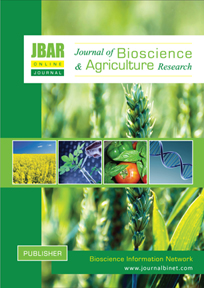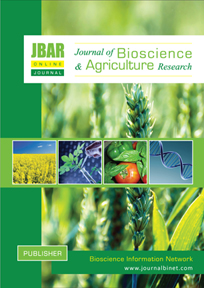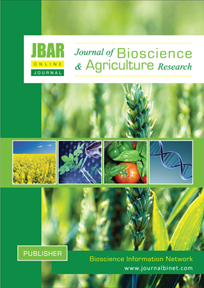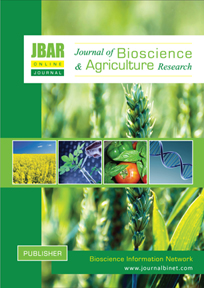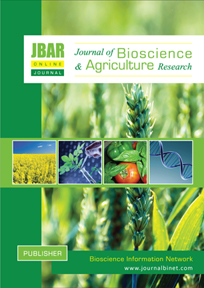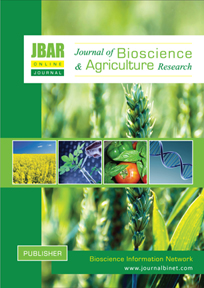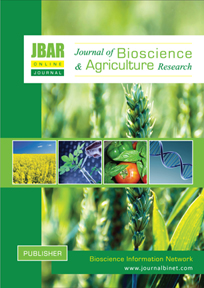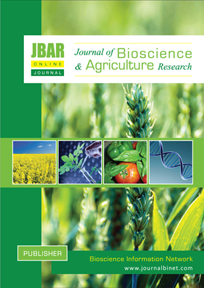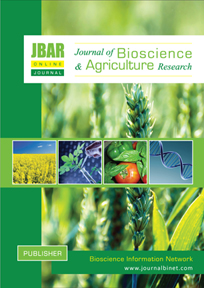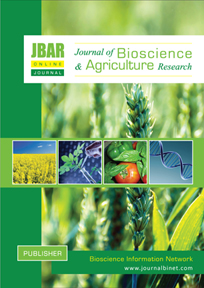Journal of Bioscience and Agriculture Research
Volume 21 - Issue 01 | Year of Publication: 2019
Article Type: Research Article | No. 211, 2019 | Country: Bangladesh| pp. 1731-1736| Open Access
Title: Growth and yield response of cauliflower in different doses of zinc
Authors: Hossain, M. M., Habibullah, M., Hasan, M. A. M., Julie, S. N. and Hassan, M. R.
DOI: https://doi.org/10.18801/jbar.210119.211
Title: Growth and yield response of cauliflower in different doses of zinc
Authors: Hossain, M. M., Habibullah, M., Hasan, M. A. M., Julie, S. N. and Hassan, M. R.
DOI: https://doi.org/10.18801/jbar.210119.211
Growth and yield response of cauliflower in different doses of zinc
Abstract
A field experiment was conducted at Horticultural farm, Sher-e-Bangla Agricultural University, Sher-e-Bangla Nagar, Dhaka-1207 during October 2016 to February 2017 with micronutrient zinc (Zn). Zn was applied to investigate the growth, curd size and yield contributing characters of cauliflower cultivar, ‘F1 hybrid’. The experiment was laid out in Randomized Complete Block Design (RCBD) with three replications. There were three concentrations of Zn0: Control, Zn1: 1.5 kg zinc ha-1, Zn2: 2 kg zinc ha-1, Zn3: 2.5 kg zinc ha-1. Application of Zn3 showed maximum (42.13 cm) plant height at harvest while minimum (37.03 cm) was recorded from control treatment. Number of leaves per plant (19.23), length of the largest leaf (42.15 cm), breadth of the largest leaf (12.97 cm) at harvest, curd diameter at harvest (14.5 cm) was highest in Zn3 treatment whereas, lowest (17.24, 40.26 cm, 11.19 cm and 13.6 cm respectively) was recorded from control treatment.
Key Words: Zinc, Cauliflower, Growth, Curd and Yield characteristics
Abstract
A field experiment was conducted at Horticultural farm, Sher-e-Bangla Agricultural University, Sher-e-Bangla Nagar, Dhaka-1207 during October 2016 to February 2017 with micronutrient zinc (Zn). Zn was applied to investigate the growth, curd size and yield contributing characters of cauliflower cultivar, ‘F1 hybrid’. The experiment was laid out in Randomized Complete Block Design (RCBD) with three replications. There were three concentrations of Zn0: Control, Zn1: 1.5 kg zinc ha-1, Zn2: 2 kg zinc ha-1, Zn3: 2.5 kg zinc ha-1. Application of Zn3 showed maximum (42.13 cm) plant height at harvest while minimum (37.03 cm) was recorded from control treatment. Number of leaves per plant (19.23), length of the largest leaf (42.15 cm), breadth of the largest leaf (12.97 cm) at harvest, curd diameter at harvest (14.5 cm) was highest in Zn3 treatment whereas, lowest (17.24, 40.26 cm, 11.19 cm and 13.6 cm respectively) was recorded from control treatment.
Key Words: Zinc, Cauliflower, Growth, Curd and Yield characteristics
HOW TO CITE THIS ARTICLE?
MLA
Hossain, M. M. et al. “Growth and yield response of cauliflower in different doses of zinc.” Journal of Bioscience and Agriculture Research 21(01) (2019): 1731-1736.
APA
Hossain, M. M., Habibullah, M., Hasan, M. A. M., Julie, S. N. and Hassan, M. R. (2019). Growth and yield response of cauliflower in different doses of zinc. Journal of Bioscience and Agriculture Research, 21(01), 1731-1736.
Chicago
Hossain, M. M., Habibullah, M., Hasan, M. A. M., Julie, S. N. and Hassan, M. R. “Growth and yield response of cauliflower in different doses of zinc.” Journal of Bioscience and Agriculture Research 21(01) (2019): 1731-1736.
Harvard
Hossain, M. M., Habibullah, M., Hasan, M. A. M., Julie, S. N. and Hassan, M. R. 2019. Growth and yield response of cauliflower in different doses of zinc. Journal of Bioscience and Agriculture Research, 21(01), pp. 1731-1736.
Vancouver
Hossain, MM, Habibullah, M, Hasan, MAM, Julie, SN and Hassan, MR. Growth and yield response of cauliflower in different doses of zinc. Journal of Bioscience and Agriculture Research. 2019 May 21(01): 1731-1736.
MLA
Hossain, M. M. et al. “Growth and yield response of cauliflower in different doses of zinc.” Journal of Bioscience and Agriculture Research 21(01) (2019): 1731-1736.
APA
Hossain, M. M., Habibullah, M., Hasan, M. A. M., Julie, S. N. and Hassan, M. R. (2019). Growth and yield response of cauliflower in different doses of zinc. Journal of Bioscience and Agriculture Research, 21(01), 1731-1736.
Chicago
Hossain, M. M., Habibullah, M., Hasan, M. A. M., Julie, S. N. and Hassan, M. R. “Growth and yield response of cauliflower in different doses of zinc.” Journal of Bioscience and Agriculture Research 21(01) (2019): 1731-1736.
Harvard
Hossain, M. M., Habibullah, M., Hasan, M. A. M., Julie, S. N. and Hassan, M. R. 2019. Growth and yield response of cauliflower in different doses of zinc. Journal of Bioscience and Agriculture Research, 21(01), pp. 1731-1736.
Vancouver
Hossain, MM, Habibullah, M, Hasan, MAM, Julie, SN and Hassan, MR. Growth and yield response of cauliflower in different doses of zinc. Journal of Bioscience and Agriculture Research. 2019 May 21(01): 1731-1736.
Article Type: Research Article | No. 212, 2019 | Country: Bangladesh| pp. 1737-1748| Open Access
Title: Impact of salinity on seed germination and seedling growth of tomato
Authors: Nasrin, S. and Mannan, M. A.
DOI: https://doi.org/10.18801/jbar.210119.212
Title: Impact of salinity on seed germination and seedling growth of tomato
Authors: Nasrin, S. and Mannan, M. A.
DOI: https://doi.org/10.18801/jbar.210119.212
Impact of salinity on seed germination and seedling growth of tomato
Abstract
Salinity reduces tomato seed germination and lengthens the time needed for germination. The seed rate will be increase in the soils where the electrical conductivity (EC) of a saturated extract was equal to or above 8 dS m−1. A study was conducted using fifteen genetically diverse genotypes under normal and salt stress conditions. The tomato genotypes were; 8 BARI varieties (BARI tomato-2, BARI tomato-8, BARI tomato-14, BARI tomato-15, BARI tomato-16, BARI tomato-17, BARI tomato-18 and BARI tomato-19) and 7 local varieties (Bonkim Ruby, Pusa Ruby, Suraksa, Patharkuchi, Ruma VF, Ruma 19 and Guli) were used as plant material. Although, tomato (Lycopersicon esculentum Mill.) was moderately sensitive to salinity but more attention to salinity is yet to be required in the production of tomato. In present study, germination (%), speed of germination, germination energy, germination capacity, seedling vigor index, fresh and dry weights of roots and root and shoot length, were the parameters assayed on five salinity levels. Increasing salt stress negatively affected germination and seedling growth. When salt concentration increased, germination of tomato seed was reduced and the time needed to complete germination lengthened. Among the varieties, BARI tomato 14 and BARI tomato 15 were found to be the more tolerant genotypes in the present study based on studied parameters.
Key Words: Salinity, Seeds, Germination, Seedling growth and Tomato
Abstract
Salinity reduces tomato seed germination and lengthens the time needed for germination. The seed rate will be increase in the soils where the electrical conductivity (EC) of a saturated extract was equal to or above 8 dS m−1. A study was conducted using fifteen genetically diverse genotypes under normal and salt stress conditions. The tomato genotypes were; 8 BARI varieties (BARI tomato-2, BARI tomato-8, BARI tomato-14, BARI tomato-15, BARI tomato-16, BARI tomato-17, BARI tomato-18 and BARI tomato-19) and 7 local varieties (Bonkim Ruby, Pusa Ruby, Suraksa, Patharkuchi, Ruma VF, Ruma 19 and Guli) were used as plant material. Although, tomato (Lycopersicon esculentum Mill.) was moderately sensitive to salinity but more attention to salinity is yet to be required in the production of tomato. In present study, germination (%), speed of germination, germination energy, germination capacity, seedling vigor index, fresh and dry weights of roots and root and shoot length, were the parameters assayed on five salinity levels. Increasing salt stress negatively affected germination and seedling growth. When salt concentration increased, germination of tomato seed was reduced and the time needed to complete germination lengthened. Among the varieties, BARI tomato 14 and BARI tomato 15 were found to be the more tolerant genotypes in the present study based on studied parameters.
Key Words: Salinity, Seeds, Germination, Seedling growth and Tomato
HOW TO CITE THIS ARTICLE?
MLA
Nasrin and Mannan. “Impact of salinity on seed germination and seedling growth of tomato.” Journal of Bioscience and Agriculture Research 21(01) (2019): 1737-1748.
APA
Nasrin, S. and Mannan, M. A. (2019). Impact of salinity on seed germination and seedling growth of tomato. Journal of Bioscience and Agriculture Research, 21(01), 1737-1748.
Chicago
Nasrin, S. and Mannan, M. A. “Impact of salinity on seed germination and seedling growth of tomato.” Journal of Bioscience and Agriculture Research 21(01) (2019): 1737-1748.
Harvard
Nasrin, S. and Mannan, M. A. 2019. Impact of salinity on seed germination and seedling growth of tomato. Journal of Bioscience and Agriculture Research, 21(01), pp. 1737-1748.
Vancouver
Nasrin, S and Mannan, MA. Impact of salinity on seed germination and seedling growth of tomato. Journal of Bioscience and Agriculture Research. 2019 May 21(01): 1737-1748
MLA
Nasrin and Mannan. “Impact of salinity on seed germination and seedling growth of tomato.” Journal of Bioscience and Agriculture Research 21(01) (2019): 1737-1748.
APA
Nasrin, S. and Mannan, M. A. (2019). Impact of salinity on seed germination and seedling growth of tomato. Journal of Bioscience and Agriculture Research, 21(01), 1737-1748.
Chicago
Nasrin, S. and Mannan, M. A. “Impact of salinity on seed germination and seedling growth of tomato.” Journal of Bioscience and Agriculture Research 21(01) (2019): 1737-1748.
Harvard
Nasrin, S. and Mannan, M. A. 2019. Impact of salinity on seed germination and seedling growth of tomato. Journal of Bioscience and Agriculture Research, 21(01), pp. 1737-1748.
Vancouver
Nasrin, S and Mannan, MA. Impact of salinity on seed germination and seedling growth of tomato. Journal of Bioscience and Agriculture Research. 2019 May 21(01): 1737-1748
Article Type: Research Article | No. 213, 2019 | Country: Nepal| pp. 1749-1754| Open Access
Title: Vaselife analysis of gladiolus using different vase solutions
Authors: P. Mishra and A. Khanal
DOI: https://doi.org/10.18801/jbar.210119.213
Title: Vaselife analysis of gladiolus using different vase solutions
Authors: P. Mishra and A. Khanal
DOI: https://doi.org/10.18801/jbar.210119.213
Vaselife analysis of gladiolus using different vase solutions
Abstract
The experiment was conducted in the Horticulture Laboratory of Institute of Agriculture and Animal Science, Lamjung, Nepal in order to identify the effect of the different vase solution on the postharvest life of gladiolus and to find out the best vase solution that enhance and prolongs the better flower quality and the longevity. Experiment was carried out with the nine treatment T1 (distilled water), T2 (150ppm HQS + 4% sucrose), T3 (250ppm citric acid), T4 (150ppm GA3 + 4% Sucrose), T5 (150ppm HQS+150ppm AgNO3 + 4% sucrose),T6 (4% sucrose), T7 (150ppm AgNO3 + 4% sucrose), T8 (250ppm citric acid + 4% sucrose), T9 (150ppm salicylic acid + 4% sucrose) under completely randomized design with three replications. Gladiolus (white friendship) spikes were harvested at 2-3 floret color break stage and two spikes after the slanting cut were kept in each vase. The vase solution 150ppm HQS + 150ppm AgNO3 + 4% sucrose showed maximum water uptake; longer days for basal floret senescence (8 days) with the maximum floret open during basal senescence (9.76), maximum flowering 83.20 %, minimum fresh weight loss(18.03% at 12 days) and the longest vase life of 15 days followed by 150ppm salicylic acid + 4% sucrose (11.67days), 250ppm citric acid + 4% sucrose (10.67 days) whereas short vase life of 5 days was observed in control. 150ppm HQS + 150ppm AgNO3 + 4% sucrose vase solution was found best to extend the vase life of gladiolus.
Key Words: Antimicrobial, Ethylene inhibitor, Gladiolus, Sucrose and Vaselife
Abstract
The experiment was conducted in the Horticulture Laboratory of Institute of Agriculture and Animal Science, Lamjung, Nepal in order to identify the effect of the different vase solution on the postharvest life of gladiolus and to find out the best vase solution that enhance and prolongs the better flower quality and the longevity. Experiment was carried out with the nine treatment T1 (distilled water), T2 (150ppm HQS + 4% sucrose), T3 (250ppm citric acid), T4 (150ppm GA3 + 4% Sucrose), T5 (150ppm HQS+150ppm AgNO3 + 4% sucrose),T6 (4% sucrose), T7 (150ppm AgNO3 + 4% sucrose), T8 (250ppm citric acid + 4% sucrose), T9 (150ppm salicylic acid + 4% sucrose) under completely randomized design with three replications. Gladiolus (white friendship) spikes were harvested at 2-3 floret color break stage and two spikes after the slanting cut were kept in each vase. The vase solution 150ppm HQS + 150ppm AgNO3 + 4% sucrose showed maximum water uptake; longer days for basal floret senescence (8 days) with the maximum floret open during basal senescence (9.76), maximum flowering 83.20 %, minimum fresh weight loss(18.03% at 12 days) and the longest vase life of 15 days followed by 150ppm salicylic acid + 4% sucrose (11.67days), 250ppm citric acid + 4% sucrose (10.67 days) whereas short vase life of 5 days was observed in control. 150ppm HQS + 150ppm AgNO3 + 4% sucrose vase solution was found best to extend the vase life of gladiolus.
Key Words: Antimicrobial, Ethylene inhibitor, Gladiolus, Sucrose and Vaselife
HOW TO CITE THIS ARTICLE?
MLA
Mishra and Khanal. “Vaselife analysis of gladiolus using different vase solutions.” Journal of Bioscience and Agriculture Research 21(01) (2019): 1749-1754.
APA
Mishra, P. and Khanal, A. (2019). Vaselife analysis of gladiolus using different vase solutions. Journal of Bioscience and Agriculture Research, 21(01), 1749-1754.
Chicago
Mishra, P. and Khanal, A. “Vaselife analysis of gladiolus using different vase solutions.” Journal of Bioscience and Agriculture Research 21(01) (2019): 1749-1754.
Harvard
Mishra, P. and Khanal, A. 2019. Vaselife analysis of gladiolus using different vase solutions. Journal of Bioscience and Agriculture Research, 21(01), pp. 1749-1754.
Vancouver
Mishra, P and Khanal, A. Vaselife analysis of gladiolus using different vase solutions. Journal of Bioscience and Agriculture Research. 2019 May 21(01): 1749-1754.
MLA
Mishra and Khanal. “Vaselife analysis of gladiolus using different vase solutions.” Journal of Bioscience and Agriculture Research 21(01) (2019): 1749-1754.
APA
Mishra, P. and Khanal, A. (2019). Vaselife analysis of gladiolus using different vase solutions. Journal of Bioscience and Agriculture Research, 21(01), 1749-1754.
Chicago
Mishra, P. and Khanal, A. “Vaselife analysis of gladiolus using different vase solutions.” Journal of Bioscience and Agriculture Research 21(01) (2019): 1749-1754.
Harvard
Mishra, P. and Khanal, A. 2019. Vaselife analysis of gladiolus using different vase solutions. Journal of Bioscience and Agriculture Research, 21(01), pp. 1749-1754.
Vancouver
Mishra, P and Khanal, A. Vaselife analysis of gladiolus using different vase solutions. Journal of Bioscience and Agriculture Research. 2019 May 21(01): 1749-1754.
Article Type: Research Article | No. 214, 2019 | Country: Bangladesh| pp. 1755-1761| Open Access
Title: Intercropping of pointed gourd with leafy vegetable and spices
Authors: Akther, M. A., Parvin, S., Mollah, M. R. A. and Akther, S.
DOI: https://doi.org/10.18801/jbar.210119.214
Title: Intercropping of pointed gourd with leafy vegetable and spices
Authors: Akther, M. A., Parvin, S., Mollah, M. R. A. and Akther, S.
DOI: https://doi.org/10.18801/jbar.210119.214
Intercropping of pointed gourd with leafy vegetable and spices
Abstract
Intercropping, a method of crop intensification practiced produces more food per unit area and also used the maximum land of a country. In this study, to find out the performance of pointed gourd (Trichosanthes dioica) intercropped with two leafy vegetables (Redamaranth, Amaranthus cruentus & Spinach, Beta vulgari) and one spices (Coriander, Coriandrum sativum). An intercropping experiment was conducted at the farmer’s field of Multi location Testing (MLT) site (medium highland under AEZ-03), Goneshpur of Shibganj upazilla under Bogura district during two consecutive rabi season of 2012-13 to 2013-14. The experiment was laid out in randomized complete block design (RCBD) with six replications. There were four treatments viz.T1 = Sole pointed gourd (100%), T2= 100% pointed gourd + 50% red amaranth, T3 = 100% pointed gourd + 50% spinach and T4 = 100% pointed gourd + 50% coriander. The highest pointed gourd equivalent yield (29.36 t ha-1) and higher gross return (TK. 446288 t ha-1) were found from T4 (100% pointed gourd + 50% coriander) which was statistically similar to T3 (100% pointed gourd + 50% spinach) & T2 (100% pointed gourd + 50% red amaranth. The lowest equivalent yield (24.11 t ha-1) and lowest BCR (3.46) were obtained from respective sole pointed gourd in the experiment. The result revealed that all the intercrops produced higher in terms of pointed gourd equivalent yield, gross return, gross margin and benefit cost ratio (BCR) over the sole pointed gourd in both the years. Therefore, the suitable intercropping system pointed gourd with spices crop is more profitable than that of other intercropping system in Bogura region.
Key Words: Intercrop, Pointed gourd, Equivalent yield, Spinach, Red amaranth and Coriander
Abstract
Intercropping, a method of crop intensification practiced produces more food per unit area and also used the maximum land of a country. In this study, to find out the performance of pointed gourd (Trichosanthes dioica) intercropped with two leafy vegetables (Redamaranth, Amaranthus cruentus & Spinach, Beta vulgari) and one spices (Coriander, Coriandrum sativum). An intercropping experiment was conducted at the farmer’s field of Multi location Testing (MLT) site (medium highland under AEZ-03), Goneshpur of Shibganj upazilla under Bogura district during two consecutive rabi season of 2012-13 to 2013-14. The experiment was laid out in randomized complete block design (RCBD) with six replications. There were four treatments viz.T1 = Sole pointed gourd (100%), T2= 100% pointed gourd + 50% red amaranth, T3 = 100% pointed gourd + 50% spinach and T4 = 100% pointed gourd + 50% coriander. The highest pointed gourd equivalent yield (29.36 t ha-1) and higher gross return (TK. 446288 t ha-1) were found from T4 (100% pointed gourd + 50% coriander) which was statistically similar to T3 (100% pointed gourd + 50% spinach) & T2 (100% pointed gourd + 50% red amaranth. The lowest equivalent yield (24.11 t ha-1) and lowest BCR (3.46) were obtained from respective sole pointed gourd in the experiment. The result revealed that all the intercrops produced higher in terms of pointed gourd equivalent yield, gross return, gross margin and benefit cost ratio (BCR) over the sole pointed gourd in both the years. Therefore, the suitable intercropping system pointed gourd with spices crop is more profitable than that of other intercropping system in Bogura region.
Key Words: Intercrop, Pointed gourd, Equivalent yield, Spinach, Red amaranth and Coriander
HOW TO CITE THIS ARTICLE?
MLA
Akther, et al.“Intercropping of pointed gourd with leafy vegetable and spices.”Journal of Bioscience and Agriculture Research 21(01) (2019):1755-1761.
APA
Akther, M. A., Parvin, S., Mollah, M. R. A. and Akther, S. (2019). Intercropping of pointed gourd with leafy vegetable and spices.Journal of Bioscience and Agriculture Research, 21(01), 1755-1761.
Chicago
Akther, M. A., Parvin, S., Mollah, M. R. A. and Akther, S. “Intercropping of pointed gourd with leafy vegetable and spices”. Journal of Bioscience and Agriculture Research 21(01) (2019):1755-1761.
Harvard
Akther, M. A., Parvin, S., Mollah, M. R. A. and Akther, S. 2019. Intercropping of pointed gourd with leafy vegetable and spices. Journal of Bioscience and Agriculture Research, 21(01) pp.1755-1761.
Vancouver
Akther, MA, Parvin, S, Mollah, MRA and Akther, S. Intercropping of pointed gourd with leafy vegetable and spices. Journal of Bioscience and Agriculture Research. May 2019 21(01):1755-1761.
MLA
Akther, et al.“Intercropping of pointed gourd with leafy vegetable and spices.”Journal of Bioscience and Agriculture Research 21(01) (2019):1755-1761.
APA
Akther, M. A., Parvin, S., Mollah, M. R. A. and Akther, S. (2019). Intercropping of pointed gourd with leafy vegetable and spices.Journal of Bioscience and Agriculture Research, 21(01), 1755-1761.
Chicago
Akther, M. A., Parvin, S., Mollah, M. R. A. and Akther, S. “Intercropping of pointed gourd with leafy vegetable and spices”. Journal of Bioscience and Agriculture Research 21(01) (2019):1755-1761.
Harvard
Akther, M. A., Parvin, S., Mollah, M. R. A. and Akther, S. 2019. Intercropping of pointed gourd with leafy vegetable and spices. Journal of Bioscience and Agriculture Research, 21(01) pp.1755-1761.
Vancouver
Akther, MA, Parvin, S, Mollah, MRA and Akther, S. Intercropping of pointed gourd with leafy vegetable and spices. Journal of Bioscience and Agriculture Research. May 2019 21(01):1755-1761.
Article Type: Research Article | No. 215, 2019 | Country: Bangladesh| pp. 1762-1766| Open Access
Title: Evaluation of insecticidal activity of Ni (II) Cystine against the red flour beetle (Tribolium casteneum)
Authors: Jesmin A. M., J. A. Khanam, M. Rakibuzzaman and Jamal Uddin, A. F. M.
DOI: https://doi.org/10.18801/jbar.210119.215
Title: Evaluation of insecticidal activity of Ni (II) Cystine against the red flour beetle (Tribolium casteneum)
Authors: Jesmin A. M., J. A. Khanam, M. Rakibuzzaman and Jamal Uddin, A. F. M.
DOI: https://doi.org/10.18801/jbar.210119.215
Evaluation of insecticidal activity of Ni (II) Cystine against the red flour beetle (Tribolium casteneum)
Abstract
The study was accomplished at the Crop protection and Toxicology Laboratory, Department of Zoology, Rajshahi University to evaluate the insecticidal activity of Ni (II) Cystine against red flour beetle. The main aim of this research is to evaluate the insecticidal activity of Ni (ii) cystine against the red flour beetle. Residual film bioassay and fumigation bioassay test were done and four doses of stock solution viz. S1: 2 ml, S2: 1 ml, S3: 0.5 ml and S4: 0.25 ml used in this study. Among them Residual film bioassay with S1 showed strong activity against red flour beetle while fumigation test showed no activity on T. casteneum. Highest mortality (70%) found in film method and LD50 found 0.62 mg cm-2 in film bioassay test. Therefore, this study reveals that residual film method and Ni (II) cysteine has potential insecticidal activity against red flour beetle.
Key Words: Film bioassay, Fumigation bioassay, Red flour beetle and Mortality
Abstract
The study was accomplished at the Crop protection and Toxicology Laboratory, Department of Zoology, Rajshahi University to evaluate the insecticidal activity of Ni (II) Cystine against red flour beetle. The main aim of this research is to evaluate the insecticidal activity of Ni (ii) cystine against the red flour beetle. Residual film bioassay and fumigation bioassay test were done and four doses of stock solution viz. S1: 2 ml, S2: 1 ml, S3: 0.5 ml and S4: 0.25 ml used in this study. Among them Residual film bioassay with S1 showed strong activity against red flour beetle while fumigation test showed no activity on T. casteneum. Highest mortality (70%) found in film method and LD50 found 0.62 mg cm-2 in film bioassay test. Therefore, this study reveals that residual film method and Ni (II) cysteine has potential insecticidal activity against red flour beetle.
Key Words: Film bioassay, Fumigation bioassay, Red flour beetle and Mortality
HOW TO CITE THIS ARTICLE?
MLA
Jesmin, A. M. et al. “Evaluation of insecticidal activity of Ni (II) Cystine against the red flour beetle (Tribolium casteneum).” Journal of Bioscience and Agriculture Research 21(01) (2019): 1762-1766.
APA
Jesmin, A. M., J. A. Khanam, M. Rakibuzzaman and Jamal Uddin, A. F. M. (2019). Evaluation of insecticidal activity of Ni (II) Cystine against the red flour beetle (Tribolium casteneum). Journal of Bioscience and Agriculture Research, 21(01), 1762-1766.
Chicago
Jesmin, A. M., J. A. Khanam, M. Rakibuzzaman and Jamal Uddin, A. F. M. “Evaluation of insecticidal activity of Ni (II) Cystine against the red flour beetle (Tribolium casteneum).” Journal of Bioscience and Agriculture Research 21(01) (2019): 1762-1766.
Harvard
Jesmin, A. M., J. A. Khanam, M. Rakibuzzaman and Jamal Uddin, A. F. M. 2019. Evaluation of insecticidal activity of Ni (II) Cystine against the red flour beetle (Tribolium casteneum). Journal of Bioscience and Agriculture Research, 21(01), pp. 1762-1766.
Vancouver
Jesmin AM, JA Khanam, M Rakibuzzaman and Jamal Uddin, AFM. Evaluation of insecticidal activity of Ni (II) Cystine against the red flour beetle (Tribolium casteneum). Journal of Bioscience and Agriculture Research. 2019 May 21(01): 1762-1766.
MLA
Jesmin, A. M. et al. “Evaluation of insecticidal activity of Ni (II) Cystine against the red flour beetle (Tribolium casteneum).” Journal of Bioscience and Agriculture Research 21(01) (2019): 1762-1766.
APA
Jesmin, A. M., J. A. Khanam, M. Rakibuzzaman and Jamal Uddin, A. F. M. (2019). Evaluation of insecticidal activity of Ni (II) Cystine against the red flour beetle (Tribolium casteneum). Journal of Bioscience and Agriculture Research, 21(01), 1762-1766.
Chicago
Jesmin, A. M., J. A. Khanam, M. Rakibuzzaman and Jamal Uddin, A. F. M. “Evaluation of insecticidal activity of Ni (II) Cystine against the red flour beetle (Tribolium casteneum).” Journal of Bioscience and Agriculture Research 21(01) (2019): 1762-1766.
Harvard
Jesmin, A. M., J. A. Khanam, M. Rakibuzzaman and Jamal Uddin, A. F. M. 2019. Evaluation of insecticidal activity of Ni (II) Cystine against the red flour beetle (Tribolium casteneum). Journal of Bioscience and Agriculture Research, 21(01), pp. 1762-1766.
Vancouver
Jesmin AM, JA Khanam, M Rakibuzzaman and Jamal Uddin, AFM. Evaluation of insecticidal activity of Ni (II) Cystine against the red flour beetle (Tribolium casteneum). Journal of Bioscience and Agriculture Research. 2019 May 21(01): 1762-1766.
Volume 21 - Issue 02 | Year of Publication: 2019
Article Type: Research Article | No. 216, 2019 | Country: Bangladesh| pp. 1767-1777| Open Access
Title: Study on the production and profitability of BRRI dhan50 cultivation in south-western region of Bangladesh
Authors: S. Naznin, S. S. Islam, M. S. Islam, H. Rashid and D. Mahalder
DOI: https://doi.org/10.18801/jbar.210119.216
Title: Study on the production and profitability of BRRI dhan50 cultivation in south-western region of Bangladesh
Authors: S. Naznin, S. S. Islam, M. S. Islam, H. Rashid and D. Mahalder
DOI: https://doi.org/10.18801/jbar.210119.216
Study on the production and profitability of BRRI dhan50 cultivation in south-western region of Bangladesh
Abstract
Knowledge gap and lack of practical experience of farmers are the main impediments to cultivate BRRI dhan50 in south-western region of Bangladesh. BRRI dhan50 is of interest as a means of addressing the higher production cost and lower profitability of the existing Boro cultivars. Therefore the present study was conducted to estimate the production and profitability of BRRI dhan50 rice in selected areas of Bagerhat, Satkhira and Khulna districts. An interview schedule was prepared containing all relevant questions and farmers responded the questions from their regular practice and experience. Primary data were collected from the randomly selected farmers during the period from August to September, 2016. During calculation of total production costs, purchase costs of seed, manure, fertilizer, and insecticides as well as cost of power tiller rent, irrigation, and land rent were taken into account. Per hectare costs were calculated for all inputs including farmer’s own labor and hired labor and all other materials costs for producing BRRI dhan50 rice. Collected data were analyzed using SPSS 16.0and MS Excel program which helped to address the main objectives of the study. Cost and return analysis showed that input cost (cash costs) incurred for producing BRRI dhan50 in Bagerhat, Khulna and Satkhira were 82,555.34±1460.15, 83,228.03±852.13 and 76,148.51±1423.35 BDT/ha, respectively. The estimated fixed costs for producing BRRI dhan50 in Bagerhat, Khulna and Satkhira were 22,151.81±60.84, 25,411.09±292.70 and 27,630.01±128.74 BDT/ha, respectively. In south-western region, average total cost for BRRI dhan50 production was 105,815.62±927.84 BDT/ha. Gross return from BRRI dhan50 cultivation in Bagerhat, Khulna and Satkhira were BDT 107,761.3±3582.10, 125,383.9±3073.08 and 135,415.5±3300.78/ha, respectively. Accordingly, per hectare net return from BRRI dhan50 cultivation showed highly significant differences (P<0.001) in three districts where the means were 3054.2±2062.72, 16,744.63±2080.21 and 31,636.97±3270.48 BDT/hafor Bagerhat, Khulna and Satkhira, respectively. Average yield of BRRI dhan50 in these regions was observed 5.73±0.08 t/ha. The findings of the present study indicate that net return of BRRI dhan50 rice cultivation was highest in Satkhira district compare to Bagerhat and Khulna. However, the profit margin was very low because farmers received lower prices of rice during harvesting time and over the year.
Key Words: BRRI dhan50, Production, Profitability and Cultivation
Abstract
Knowledge gap and lack of practical experience of farmers are the main impediments to cultivate BRRI dhan50 in south-western region of Bangladesh. BRRI dhan50 is of interest as a means of addressing the higher production cost and lower profitability of the existing Boro cultivars. Therefore the present study was conducted to estimate the production and profitability of BRRI dhan50 rice in selected areas of Bagerhat, Satkhira and Khulna districts. An interview schedule was prepared containing all relevant questions and farmers responded the questions from their regular practice and experience. Primary data were collected from the randomly selected farmers during the period from August to September, 2016. During calculation of total production costs, purchase costs of seed, manure, fertilizer, and insecticides as well as cost of power tiller rent, irrigation, and land rent were taken into account. Per hectare costs were calculated for all inputs including farmer’s own labor and hired labor and all other materials costs for producing BRRI dhan50 rice. Collected data were analyzed using SPSS 16.0and MS Excel program which helped to address the main objectives of the study. Cost and return analysis showed that input cost (cash costs) incurred for producing BRRI dhan50 in Bagerhat, Khulna and Satkhira were 82,555.34±1460.15, 83,228.03±852.13 and 76,148.51±1423.35 BDT/ha, respectively. The estimated fixed costs for producing BRRI dhan50 in Bagerhat, Khulna and Satkhira were 22,151.81±60.84, 25,411.09±292.70 and 27,630.01±128.74 BDT/ha, respectively. In south-western region, average total cost for BRRI dhan50 production was 105,815.62±927.84 BDT/ha. Gross return from BRRI dhan50 cultivation in Bagerhat, Khulna and Satkhira were BDT 107,761.3±3582.10, 125,383.9±3073.08 and 135,415.5±3300.78/ha, respectively. Accordingly, per hectare net return from BRRI dhan50 cultivation showed highly significant differences (P<0.001) in three districts where the means were 3054.2±2062.72, 16,744.63±2080.21 and 31,636.97±3270.48 BDT/hafor Bagerhat, Khulna and Satkhira, respectively. Average yield of BRRI dhan50 in these regions was observed 5.73±0.08 t/ha. The findings of the present study indicate that net return of BRRI dhan50 rice cultivation was highest in Satkhira district compare to Bagerhat and Khulna. However, the profit margin was very low because farmers received lower prices of rice during harvesting time and over the year.
Key Words: BRRI dhan50, Production, Profitability and Cultivation
HOW TO CITE THIS ARTICLE?
MLA
Naznin, S. et al. “Study on the production and profitability of BRRI dhan50 cultivation in south-western region of Bangladesh.” Journal of Bioscience and Agriculture Research 21(02) (2019): 1767-1777.
APA
Naznin, S., Islam, S. S., Islam, M. S., Rashid, H. and Mahalder, D. (2019). Study on the production and profitability of BRRI dhan50 cultivation in south-western region of Bangladesh. Journal of Bioscience and Agriculture Research, 21(02), 1767-1777.
Chicago
Naznin, S., Islam, S. S., Islam, M. S., Rashid, H. and Mahalder, D. “Study on the production and profitability of BRRI dhan50 cultivation in south-western region of Bangladesh.” Journal of Bioscience and Agriculture Research 21(02) (2019): 1767-1777.
Harvard
Naznin, S., Islam, S. S., Islam, M. S., Rashid, H. and Mahalder, D. 2019. Study on the production and profitability of BRRI dhan50 cultivation in south-western region of Bangladesh. Journal of Bioscience and Agriculture Research, 21(02), pp. 1767-1777.
Vancouver
Naznin, S, Islam, SS, Islam, MS, Rashid, H and Mahalder, D. Study on the production and profitability of BRRI dhan50 cultivation in south-western region of Bangladesh. Journal of Bioscience and Agriculture Research. 2019 June 21(02): 1767-1777.
MLA
Naznin, S. et al. “Study on the production and profitability of BRRI dhan50 cultivation in south-western region of Bangladesh.” Journal of Bioscience and Agriculture Research 21(02) (2019): 1767-1777.
APA
Naznin, S., Islam, S. S., Islam, M. S., Rashid, H. and Mahalder, D. (2019). Study on the production and profitability of BRRI dhan50 cultivation in south-western region of Bangladesh. Journal of Bioscience and Agriculture Research, 21(02), 1767-1777.
Chicago
Naznin, S., Islam, S. S., Islam, M. S., Rashid, H. and Mahalder, D. “Study on the production and profitability of BRRI dhan50 cultivation in south-western region of Bangladesh.” Journal of Bioscience and Agriculture Research 21(02) (2019): 1767-1777.
Harvard
Naznin, S., Islam, S. S., Islam, M. S., Rashid, H. and Mahalder, D. 2019. Study on the production and profitability of BRRI dhan50 cultivation in south-western region of Bangladesh. Journal of Bioscience and Agriculture Research, 21(02), pp. 1767-1777.
Vancouver
Naznin, S, Islam, SS, Islam, MS, Rashid, H and Mahalder, D. Study on the production and profitability of BRRI dhan50 cultivation in south-western region of Bangladesh. Journal of Bioscience and Agriculture Research. 2019 June 21(02): 1767-1777.
Article Type: Research Article | No. 217, 2019 | Country: Bangladesh| pp. 1778-1785| Open Access
Title: A practice of agro-met advisory service in Nepal
Authors: Timilsina, A. P., Shrestha, A., Gautam, A. K., Gaire, A., Malla, G., Paudel, B. P., Rimal, R., Upadhyay, K. P. and Bhandari, H. L.
DOI: https://doi.org/10.18801/jbar.210219.217
Title: A practice of agro-met advisory service in Nepal
Authors: Timilsina, A. P., Shrestha, A., Gautam, A. K., Gaire, A., Malla, G., Paudel, B. P., Rimal, R., Upadhyay, K. P. and Bhandari, H. L.
DOI: https://doi.org/10.18801/jbar.210219.217
A practice of agro-met advisory service in Nepal
Abstract
Agriculture is highly dependable on the weather. Nepalese agriculture is being affected by the various weather events as well as the climate change. In this context, agro-met advisory services help farmers to optimize their production through timely and judicious resources management based on the weather information and reduce the losses caused by vulnerable weather. The agro-met advisory generation in Nepal is a very appreciable approach from the Government of Nepal. The information and coverage of domain have been increased as bulletin preparation moves forwards. However, there are few factors to hinder its effectiveness. The complex topography of Nepal with little infrastructure and workforce for providing the higher resolution weather forecast is the foremost. In addition, Nepal lacks information on the functional relationship between various components of the Nepalese agriculture and weather. Furthermore, the change in the structure of the agriculture extension system in the federal policy, the dissemination of the information is challenging. Being optimistic, the lessons from the current practices in conjunction with the improvement made on every factor of the hindrances, the agro-met advisories could be a boon for the Nepalese farmers in the near future.
Key Words: Weather, Crops, Fisheries, Livestock and Bulletin
Abstract
Agriculture is highly dependable on the weather. Nepalese agriculture is being affected by the various weather events as well as the climate change. In this context, agro-met advisory services help farmers to optimize their production through timely and judicious resources management based on the weather information and reduce the losses caused by vulnerable weather. The agro-met advisory generation in Nepal is a very appreciable approach from the Government of Nepal. The information and coverage of domain have been increased as bulletin preparation moves forwards. However, there are few factors to hinder its effectiveness. The complex topography of Nepal with little infrastructure and workforce for providing the higher resolution weather forecast is the foremost. In addition, Nepal lacks information on the functional relationship between various components of the Nepalese agriculture and weather. Furthermore, the change in the structure of the agriculture extension system in the federal policy, the dissemination of the information is challenging. Being optimistic, the lessons from the current practices in conjunction with the improvement made on every factor of the hindrances, the agro-met advisories could be a boon for the Nepalese farmers in the near future.
Key Words: Weather, Crops, Fisheries, Livestock and Bulletin
HOW TO CITE THIS ARTICLE?
MLA
Timilsina, A. P. et al. “A practice of agro-met advisory service in Nepal.” Journal of Bioscience and Agriculture Research 21(02) (2019): 1778-1785.
APA
Timilsina, A. P., Shrestha, A., Gautam, A. K., Gaire, A., Malla, G., Paudel, B. P., Rimal, R., Upadhyay, K. P. and Bhandari, H. L. (2019). A practice of agro-met advisory service in Nepal. Journal of Bioscience and Agriculture Research, 21(02), 1778-1785.
Chicago
Timilsina, A. P., Shrestha, A., Gautam, A. K., Gaire, A., Malla, G., Paudel, B. P., Rimal, R., Upadhyay, K. P. and Bhandari, H. L. “A practice of agro-met advisory service in Nepal.” Journal of Bioscience and Agriculture Research 21(02) (2019): 1778-1785.
Harvard
Timilsina, A. P., Shrestha, A., Gautam, A. K., Gaire, A., Malla, G., Paudel, B. P., Rimal, R., Upadhyay, K. P. and Bhandari, H. L. 2019. A practice of agro-met advisory service in Nepal. Journal of Bioscience and Agriculture Research, 21(02), pp. 1778-1700.
Vancouver
Timilsina, AP, Shrestha, A, Gautam, AK, Gaire, A, Malla, G, Paudel, BP, Rimal, R, Upadhyay, KP and Bhandari, HL. A practice of agro-met advisory service in Nepal. Journal of Bioscience and Agriculture Research. 2019 July 21(02): 1778-1785.
MLA
Timilsina, A. P. et al. “A practice of agro-met advisory service in Nepal.” Journal of Bioscience and Agriculture Research 21(02) (2019): 1778-1785.
APA
Timilsina, A. P., Shrestha, A., Gautam, A. K., Gaire, A., Malla, G., Paudel, B. P., Rimal, R., Upadhyay, K. P. and Bhandari, H. L. (2019). A practice of agro-met advisory service in Nepal. Journal of Bioscience and Agriculture Research, 21(02), 1778-1785.
Chicago
Timilsina, A. P., Shrestha, A., Gautam, A. K., Gaire, A., Malla, G., Paudel, B. P., Rimal, R., Upadhyay, K. P. and Bhandari, H. L. “A practice of agro-met advisory service in Nepal.” Journal of Bioscience and Agriculture Research 21(02) (2019): 1778-1785.
Harvard
Timilsina, A. P., Shrestha, A., Gautam, A. K., Gaire, A., Malla, G., Paudel, B. P., Rimal, R., Upadhyay, K. P. and Bhandari, H. L. 2019. A practice of agro-met advisory service in Nepal. Journal of Bioscience and Agriculture Research, 21(02), pp. 1778-1700.
Vancouver
Timilsina, AP, Shrestha, A, Gautam, AK, Gaire, A, Malla, G, Paudel, BP, Rimal, R, Upadhyay, KP and Bhandari, HL. A practice of agro-met advisory service in Nepal. Journal of Bioscience and Agriculture Research. 2019 July 21(02): 1778-1785.
Article Type: Research Article | No. 218, 2019 | Country: Bangladesh| pp. 1786-1793| Open Access
Title: Effect of salinity on seed germination and seedlings growth of sorghum (Sorghum bicolor l.)
Authors: Manobendra Nath Sarkar, AKM Zakir Hossain, Shahanara Begum, Syed Nazrul Islam, Sanjoy Kumar Biswas and Md. Zablul Tareq
DOI: https://doi.org/10.18801/jbar.210219.218
Title: Effect of salinity on seed germination and seedlings growth of sorghum (Sorghum bicolor l.)
Authors: Manobendra Nath Sarkar, AKM Zakir Hossain, Shahanara Begum, Syed Nazrul Islam, Sanjoy Kumar Biswas and Md. Zablul Tareq
DOI: https://doi.org/10.18801/jbar.210219.218
Effect of salinity on seed germination and seedlings growth of sorghum (Sorghum bicolor l.)
Abstract
A laboratory experiment was conducted to investigate salt tolerant sorghum genotypes based on morphological characters of nine sorghum genotypes during germination and seedling growth. The treatments were consisted of 0mM and 100mM NaCl and nine genotypes were BD 686, BD 687, BD 693, BD 699, BD 700, BD 747, BD 748, BD 750, BD 753. The experiment was laid out in a CRD with 3 replications. The plants were grown hydroponically in the plant physiology laboratory, Department of Crop Botany, BAU, Mymensingh. Under salinity stressed (0 and 100 mMNaCl) condition, tolerant genotypes BD 750 and BD 686 showed higher germination percentage, different stress tolerance index (GSTI, SLSI, RLSI,FSTI and DSTI), shoot and root length, fresh weight , dry weight, leaf area (LA), vigor index than those in sensitive genotype BD 747 and BD 753. The underlying mechanism to these changes was described in details.
Key Words: Salinity, Seed germination, Seedling growth and Sorghum
Abstract
A laboratory experiment was conducted to investigate salt tolerant sorghum genotypes based on morphological characters of nine sorghum genotypes during germination and seedling growth. The treatments were consisted of 0mM and 100mM NaCl and nine genotypes were BD 686, BD 687, BD 693, BD 699, BD 700, BD 747, BD 748, BD 750, BD 753. The experiment was laid out in a CRD with 3 replications. The plants were grown hydroponically in the plant physiology laboratory, Department of Crop Botany, BAU, Mymensingh. Under salinity stressed (0 and 100 mMNaCl) condition, tolerant genotypes BD 750 and BD 686 showed higher germination percentage, different stress tolerance index (GSTI, SLSI, RLSI,FSTI and DSTI), shoot and root length, fresh weight , dry weight, leaf area (LA), vigor index than those in sensitive genotype BD 747 and BD 753. The underlying mechanism to these changes was described in details.
Key Words: Salinity, Seed germination, Seedling growth and Sorghum
HOW TO CITE THIS ARTICLE?
MLA
Sarker, et al. “Effect of salinity on seed germination and seedlings growth of sorghum (Sorghum bicolor l.)”. Journal of Bioscience and Agriculture Research, 21(02) (2019): 1786-1793.
APA
Sarker, M. N., Hossain, A. K. M. Z., Begum, S., Islam, S. N., Biswas, S. K. and Tareq, M. Z. (2019). Effect of salinity on seed germination and seedlings growth of sorghum (Sorghum bicolor l.). Journal of Bioscience and Agriculture Research, 21(02), 1786-1793.
Chicago
Sarker, M. N., Hossain, A. K. M. Z., Begum, S., Islam, S. N., Biswas, S. K. and Tareq, M. Z. “Effect of salinity on seed germination and seedlings growth of sorghum (Sorghum bicolor l.)”. Journal of Bioscience and Agriculture Research, 21(02) (2019): 1786-1793.
Harvard
Sarker, M. N., Hossain, A. K. M. Z., Begum, S., Islam, S. N., Biswas, S. K. and Tareq, M. Z. 2019. Effect of salinity on seed germination and seedlings growth of sorghum (Sorghum bicolor l.). Journal of Bioscience and Agriculture Research, 21(02), pp. 1786-1793.
Vancouver
Sarker, MN, Hossain, AKMZ, Begum, S, Islam, SN, Biswas, SK and Tareq, MZ. Effect of salinity on seed germination and seedlings growth of sorghum (Sorghum bicolor l.). Journal of Bioscience and Agriculture Research. 2019 July 21(02): 1786-1793.
MLA
Sarker, et al. “Effect of salinity on seed germination and seedlings growth of sorghum (Sorghum bicolor l.)”. Journal of Bioscience and Agriculture Research, 21(02) (2019): 1786-1793.
APA
Sarker, M. N., Hossain, A. K. M. Z., Begum, S., Islam, S. N., Biswas, S. K. and Tareq, M. Z. (2019). Effect of salinity on seed germination and seedlings growth of sorghum (Sorghum bicolor l.). Journal of Bioscience and Agriculture Research, 21(02), 1786-1793.
Chicago
Sarker, M. N., Hossain, A. K. M. Z., Begum, S., Islam, S. N., Biswas, S. K. and Tareq, M. Z. “Effect of salinity on seed germination and seedlings growth of sorghum (Sorghum bicolor l.)”. Journal of Bioscience and Agriculture Research, 21(02) (2019): 1786-1793.
Harvard
Sarker, M. N., Hossain, A. K. M. Z., Begum, S., Islam, S. N., Biswas, S. K. and Tareq, M. Z. 2019. Effect of salinity on seed germination and seedlings growth of sorghum (Sorghum bicolor l.). Journal of Bioscience and Agriculture Research, 21(02), pp. 1786-1793.
Vancouver
Sarker, MN, Hossain, AKMZ, Begum, S, Islam, SN, Biswas, SK and Tareq, MZ. Effect of salinity on seed germination and seedlings growth of sorghum (Sorghum bicolor l.). Journal of Bioscience and Agriculture Research. 2019 July 21(02): 1786-1793.
Article Type: Research Article | No. 219, 2019 | Country: Bangladesh| pp. 1794-1798| Open Access
Title: Study on fertility, hatchability and body weight of chicken in reciprocal crosses
Authors: Mamunur Rahman, Shonkor Kumar Das and Sachchidananda Das Chowdhury
DOI: https://doi.org/10.18801/jbar.210219.219
Title: Study on fertility, hatchability and body weight of chicken in reciprocal crosses
Authors: Mamunur Rahman, Shonkor Kumar Das and Sachchidananda Das Chowdhury
DOI: https://doi.org/10.18801/jbar.210219.219
Study on fertility, hatchability and body weight of chicken in reciprocal crosses
Abstract
In order to observe the effects of reciprocal crosses on fertility, hatchability and body weight of chicken an experiment was conducted between exotic chicken and locally purchased Indigenous chicken at the Department of Animal Breeding and Genetics, Bangladesh Agricultural University, Mymensingh-2202. Three types of exotic chicken breeds were used as White Leghorn (WL), RIR and Fayomi cocks and local cocks were mated to WL, RIR and Fayoumi hens naturally. Local cocks were mated to local hens in the pens as the control group. A total of 43 chicks in 4 genetic groups were raised up to 8 weeks under identical conditions. Same management practices and feed were used for all the treated groups including control. Results revealed that weight at maturity was highest in 24 weeks of White Leghorn and Rhode Island Red but the lowest in Indigenous. Chickens weights varied different types in different types in different ages. The weight gradually decreased in WL and RIR but gradually increased in Fayoumi and Indigenous chickens. It showed that the higher growth rate, growth velocity & body weight (8 weeks) were found in case of Ind X WL, whereas, the lowest value was found in case of RIR×Ind. The average gain in weight of chicks in different stages up to eight weeks of the age of the different genotypes has also been shown in Table 2 where on an average, crossbred chicks Ind × WL, Ind × Fayoumi and Ind × RIR had the maximum gain in eight weeks of age. The general combining ability of the different exotic types which were mated reciprocally for growth rate and eight weeks body weight was non-significant although it was higher in case of WL. The growth rate, growth velocity & body weight were higher in male in case of overall reciprocal cross and lower in lower in case of specific reciprocal cross.
Key Words: Fertility, hatchability, body weight, chicken and reciprocal crosses
Abstract
In order to observe the effects of reciprocal crosses on fertility, hatchability and body weight of chicken an experiment was conducted between exotic chicken and locally purchased Indigenous chicken at the Department of Animal Breeding and Genetics, Bangladesh Agricultural University, Mymensingh-2202. Three types of exotic chicken breeds were used as White Leghorn (WL), RIR and Fayomi cocks and local cocks were mated to WL, RIR and Fayoumi hens naturally. Local cocks were mated to local hens in the pens as the control group. A total of 43 chicks in 4 genetic groups were raised up to 8 weeks under identical conditions. Same management practices and feed were used for all the treated groups including control. Results revealed that weight at maturity was highest in 24 weeks of White Leghorn and Rhode Island Red but the lowest in Indigenous. Chickens weights varied different types in different types in different ages. The weight gradually decreased in WL and RIR but gradually increased in Fayoumi and Indigenous chickens. It showed that the higher growth rate, growth velocity & body weight (8 weeks) were found in case of Ind X WL, whereas, the lowest value was found in case of RIR×Ind. The average gain in weight of chicks in different stages up to eight weeks of the age of the different genotypes has also been shown in Table 2 where on an average, crossbred chicks Ind × WL, Ind × Fayoumi and Ind × RIR had the maximum gain in eight weeks of age. The general combining ability of the different exotic types which were mated reciprocally for growth rate and eight weeks body weight was non-significant although it was higher in case of WL. The growth rate, growth velocity & body weight were higher in male in case of overall reciprocal cross and lower in lower in case of specific reciprocal cross.
Key Words: Fertility, hatchability, body weight, chicken and reciprocal crosses
HOW TO CITE THIS ARTICLE?
MLA
Rahman et al. “Study on fertility, hatchability and body weight of chicken in reciprocal crosses”. Journal of Bioscience and Agriculture Research, 21(02) (2019): 1794-1798.
APA
Rahman, M., Das, S. K. and Chowdhury, S. D. (2019). Study on fertility, hatchability and body weight of chicken in reciprocal crosses. Journal of Bioscience and Agriculture Research, 21(02), 1794-1798.
Chicago
Rahman, M., Das, S. K. and Chowdhury, S. D. “Study on fertility, hatchability and body weight of chicken in reciprocal crosses”. Journal of Bioscience and Agriculture Research 21(02)(2019): 1794-1798.
Harvard
Rahman, M., Das, S. K. and Chowdhury, S. D. 2019. Study on fertility, hatchability and body weight of chicken in reciprocal crosses”. Journal of Bioscience and Agriculture Research, 21(02), pp. 1794-1798.
Vancouver
Rahman M, Das SK, Chowdhury SD. Study on fertility, hatchability and body weight of chicken in reciprocal crosses. Journal of Bioscience and Agriculture Research, 2019 July 21(02): 1794-1798.
MLA
Rahman et al. “Study on fertility, hatchability and body weight of chicken in reciprocal crosses”. Journal of Bioscience and Agriculture Research, 21(02) (2019): 1794-1798.
APA
Rahman, M., Das, S. K. and Chowdhury, S. D. (2019). Study on fertility, hatchability and body weight of chicken in reciprocal crosses. Journal of Bioscience and Agriculture Research, 21(02), 1794-1798.
Chicago
Rahman, M., Das, S. K. and Chowdhury, S. D. “Study on fertility, hatchability and body weight of chicken in reciprocal crosses”. Journal of Bioscience and Agriculture Research 21(02)(2019): 1794-1798.
Harvard
Rahman, M., Das, S. K. and Chowdhury, S. D. 2019. Study on fertility, hatchability and body weight of chicken in reciprocal crosses”. Journal of Bioscience and Agriculture Research, 21(02), pp. 1794-1798.
Vancouver
Rahman M, Das SK, Chowdhury SD. Study on fertility, hatchability and body weight of chicken in reciprocal crosses. Journal of Bioscience and Agriculture Research, 2019 July 21(02): 1794-1798.
Article Type: Research Article | No. 220, 2019 | Country: Bangladesh| pp. 1799-1804| Open Access
Title: Comparison of sensory evaluation and storage properties of weaning food formulated by locally available raw materials with commercial cerelac
Authors: Rubina Begum, Md. Shahidul Hoque, Md. Shahadat Hossain Sarker, Mamunur Rahman, Shonkor Kumar Das and Md. Burhan Uddin
DOI: https://doi.org/10.18801/jbar.210219.220
Title: Comparison of sensory evaluation and storage properties of weaning food formulated by locally available raw materials with commercial cerelac
Authors: Rubina Begum, Md. Shahidul Hoque, Md. Shahadat Hossain Sarker, Mamunur Rahman, Shonkor Kumar Das and Md. Burhan Uddin
DOI: https://doi.org/10.18801/jbar.210219.220
Comparison of sensory evaluation and storage properties of weaning food formulated by locally available raw materials with commercial cerelac
Abstract
The sensory evaluation of weaning food is an important factor for the children worldwide. To evaluate the sensory attributes and storage properties an experiment was conducted using various formulations of weaning food using different proportions of locally available raw materials such as potato, soyabean supplement with whole milk powder. For this, seven groups of food were considered, such as, Group A (Cerelac-wheat+milk), Group B (Cerelac-wheat+3 fruits), Group 1-5 (various combinations of potato, soyabean supplement with whole milk powder). The aforesaid raw materials and various formulations of weaning foods were analyzed accordingly. Results revealed that the colour, flavour, texture and overall acceptability of different samples were significantly (p<0.01) affected. There was no significant difference in colour and flavour for the commercial products (cerelacs) and prepared product sample No. 5 (66% potato+26% soyabean + 8% whole milk powder). There was no significant difference in samples 1, 2 and 4 (66% potato + 34% soyabean or 66% potato+ 32% soyabean +2% whole milk powder or 66% potato + 28% soyabean + 6% whole milk powder). The overall acceptability of weaning food samples was not equally acceptable. The commercial products had the best overall acceptability as compared to the other samples. The sample No. 3 (66% potato + 30% soyabean + 4% whole milk powder) was the worst among the others in that regard. The other samples were equally acceptable by the judges. The storage properties were not significant. However, the other samples were equally acceptable by the judges.
Key Words: Sensory attributes, storage properties, Weaning food and Crelac.
Abstract
The sensory evaluation of weaning food is an important factor for the children worldwide. To evaluate the sensory attributes and storage properties an experiment was conducted using various formulations of weaning food using different proportions of locally available raw materials such as potato, soyabean supplement with whole milk powder. For this, seven groups of food were considered, such as, Group A (Cerelac-wheat+milk), Group B (Cerelac-wheat+3 fruits), Group 1-5 (various combinations of potato, soyabean supplement with whole milk powder). The aforesaid raw materials and various formulations of weaning foods were analyzed accordingly. Results revealed that the colour, flavour, texture and overall acceptability of different samples were significantly (p<0.01) affected. There was no significant difference in colour and flavour for the commercial products (cerelacs) and prepared product sample No. 5 (66% potato+26% soyabean + 8% whole milk powder). There was no significant difference in samples 1, 2 and 4 (66% potato + 34% soyabean or 66% potato+ 32% soyabean +2% whole milk powder or 66% potato + 28% soyabean + 6% whole milk powder). The overall acceptability of weaning food samples was not equally acceptable. The commercial products had the best overall acceptability as compared to the other samples. The sample No. 3 (66% potato + 30% soyabean + 4% whole milk powder) was the worst among the others in that regard. The other samples were equally acceptable by the judges. The storage properties were not significant. However, the other samples were equally acceptable by the judges.
Key Words: Sensory attributes, storage properties, Weaning food and Crelac.
HOW TO CITE THIS ARTICLE?
MLA
Begum, et al. “Comparison of sensory evaluation and storage properties of weaning food formulated by locally available raw materials with commercial cerelac”. Journal of Bioscience and Agriculture Research, 21(02) (2019): 1799-1804.
APA
Begum, R., Hoque, M. S., Sarker, M. S. H., Rahman, M., Das, S. K. and Uddin, M. B. (2019). Comparison of sensory evaluation and storage properties of weaning food formulated by locally available raw materials with commercial cerelac. Journal of Bioscience and Agriculture Research, 21(02), 1799-1804.
Chicago
Begum, R., Hoque, M. S., Sarker, M. S. H., Rahman, M., Das, S. K. and Uddin, M. B. “Comparison of sensory evaluation and storage properties of weaning food formulated by locally available raw materials with commercial cerelac”. Journal of Bioscience and Agriculture Research, 21(02) (2019): 1799-1804.
Harvard
Begum, R., Hoque, M. S., Sarker, M. S. H., Rahman, M., Das, S. K. and Uddin, M. B. 2019. Comparison of sensory evaluation and storage properties of weaning food formulated by locally available raw materials with commercial cerelac. Journal of Bioscience and Agriculture Research, 21(02), pp. 1799-1804.
Vancouver
Begum, R, Hoque, MS, Sarker, MSH, Rahman, M, Das, SK and Uddin, MB. Comparison of sensory evaluation and storage properties of weaning food formulated by locally available raw materials with commercial cerelac. Journal of Bioscience and Agriculture Research, 2019 July 21(02): 1799-1804
MLA
Begum, et al. “Comparison of sensory evaluation and storage properties of weaning food formulated by locally available raw materials with commercial cerelac”. Journal of Bioscience and Agriculture Research, 21(02) (2019): 1799-1804.
APA
Begum, R., Hoque, M. S., Sarker, M. S. H., Rahman, M., Das, S. K. and Uddin, M. B. (2019). Comparison of sensory evaluation and storage properties of weaning food formulated by locally available raw materials with commercial cerelac. Journal of Bioscience and Agriculture Research, 21(02), 1799-1804.
Chicago
Begum, R., Hoque, M. S., Sarker, M. S. H., Rahman, M., Das, S. K. and Uddin, M. B. “Comparison of sensory evaluation and storage properties of weaning food formulated by locally available raw materials with commercial cerelac”. Journal of Bioscience and Agriculture Research, 21(02) (2019): 1799-1804.
Harvard
Begum, R., Hoque, M. S., Sarker, M. S. H., Rahman, M., Das, S. K. and Uddin, M. B. 2019. Comparison of sensory evaluation and storage properties of weaning food formulated by locally available raw materials with commercial cerelac. Journal of Bioscience and Agriculture Research, 21(02), pp. 1799-1804.
Vancouver
Begum, R, Hoque, MS, Sarker, MSH, Rahman, M, Das, SK and Uddin, MB. Comparison of sensory evaluation and storage properties of weaning food formulated by locally available raw materials with commercial cerelac. Journal of Bioscience and Agriculture Research, 2019 July 21(02): 1799-1804

